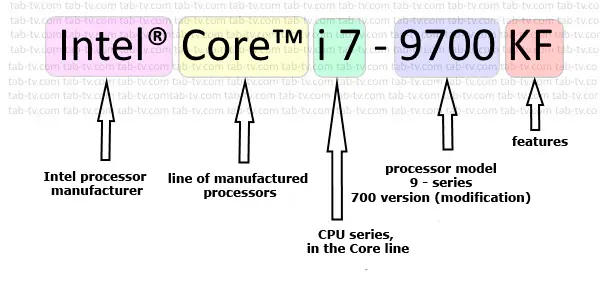What does Intel processor model number mean
How to find out the model number of the processor
The model number can be found when purchasing a processor, if the processor is installed in the working computer, you can see the parameters in the device specifications.
Intel applies the same label for all of its processor lines.

An example decoding model number Intel processors 2010-2019
Intel name
Intel is a processor manufacturer, trademark, of Intel Corporation. Intel is the only manufacturer of Intel processors.
Core name
Core – a line of processors, Intel makes processors of the following lines.
Each processor line has its own purpose or sphere of use. Core’s most famous lineup is designed for use on desktops and laptops. Xeon – for servers and data centers.
Intel Corporation has developed the following processor lines: Core ™ Xeon® Atom® Pentium® Xeon Phi ™ Quark ™ Celeron® Itanium®
What are the Intel processor series
I7 – a series of processors in the line. Processors are being improved, several series in the processor lines have been developed. So in the Core lineup there is a series of processors. Which also have features such as m-processor for mobile devices, i3 is used in office computers, i9 is optimized for work in powerful computers including gaming. The following series are produced in the Core line.
In the line of core processors, there are such a series of processors. i3, i5, i7 i9, m, x
9700 – processor model
Intel Processor Generation
9 – generation of processors. As of 2019, 9 generations of processors have been released. The first processors in the model number had no generation designation. But it was inconvenient, Intel introduced the designation of the generation of processors into the processor model number. From the second generation onwards, processors in the model number have the generation designation In each new generation of processors, there were improvements in the parameters, an increase in the frequency, support for a new memory with a higher frequency, an increase in the memory cache, a new integrated graphics, and so on. By year, processor generations are divided in this way.
- 2nd generation 2010-2011
- 3rd generation 2011-2012
- 4th generation 2012-2013
- 5th generation 2013-2014
- 6th generation 2014-2015
- 7th generation 2016-2017
- 8th generation 2017-2018
- 9th generation 2018-2019
700 – processor model, in the marking can be displayed in various numbers. Differences can be in the integrated graphics chip, the type of socket in which you can install the processor, the amount of memory cache.
KF – modification of the processor. This reflects the features of the processor, such as a processor for a desktop computer or laptop, power consumption, and more. In this case, the KF prefix KF denotes the following K – a processor without protection for increasing the clock frequency, the index f in intel processors means that the processor does not have integrated graphics. The list of possible designations of the modification is given below.
What do the last letters in the Intel processor model number mean?
- K — there is no overclocking protection
- KF – no integrated graphics
- X – high-performance processors, without limiting the multiplier value
- XE – Extreme Edition with no limit on multiplier value
- M – mobile processor
- MX – extreme mobile processors
- MQ, QM – 4-core mobile processors
- HQ – mobile processor with high-performance graphics
- P – processor without automatic overclocking and locked integrated GPU
- S – energy efficient processor performance
- T – high energy efficient processor, lower power consumption and lower frequencies
- L – energy efficient processors
- E – option for embedded systems
- QE – 4-core embedded processors
- ME – embedded mobile
- LE – performance optimized embedded processors
- UE – Energy Optimized
- U – Ultra Low Power Processors for Ultrabooks
- Y – processors with extremely low power consumption for ultrabooks
- R – processors in the case of BGA and with more efficient graphics
Processors from intel are marked which defines the basic parameters of processors.
Applicable at this time the marking has been introduced since 2011 and began to be used in the second generation series processors i3, i5, i7, i9.
The clock frequency of the nuclei depends on the type of processor and may vary to a rather large range. Also, processors have a base frequency and maximum frequency in turbo mode with Intel® Turbo Boost technology is turned on.
Model number Intel i-series processors explained

i7-7500U
I7 – processor series
7 – processor generation
500 – version of the processor, the more the more technical designation possibilities.
U – features processor
K —not by increasing clock frequency protection
- X — high performance processors, without restrictions on the value of the factor
- M — mobile processor
- MX — Extreme mobile processors
- MQ, QM — 4-core mobile processors
- HQ – mobile processor with high-performance graphics
- P — without automatic processor overclocking and blocked integrated GPU
- S — energy-efficient performance processor
- T — highly energy-efficient processor, low power consumption, and lower frequencies
- L — energy-efficient processors
- E — availability option for embedded systems
- QE — 4-core embedded processors
- ME — embedded mobile
- LE – Optimized performance embedded processors
- UE — optimized energy consumption
- U — processors with ultra low power consumption for Ultrabooks
- Y — processors with extremely low power consumption for Ultrabooks
- R — processors in the BGA package and a more powerful graphics






